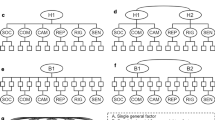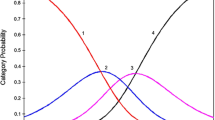Abstract
The current study was motivated by a need for a self-report questionnaire that assesses a broad range of subthreshold autism traits, is brief and easily administered, and is relevant to the general population. An initial item pool was administered to 1,709 students. Structural validity analysis resulted in a 24-item questionnaire termed the Subthreshold Autism Trait Questionnaire (SATQ; Cronbach’s alpha coefficient = .73, test–retest reliability = .79). An exploratory factor analysis suggested 5 factors. Confirmatory factor analysis indicated the 5 factor solution was an adequate fit and outperformed two other models. The SATQ successfully differentiated between an ASD and student group and demonstrated convergent validity with other ASD measures. Thus, the current study introduces and provides initial psychometric support for the SATQ.


Similar content being viewed by others
References
American Psychiatric Association. (1994). Diagnostic and statistical manual of mental disorders (4th ed.). Washington, DC: American Psychiatric Publishing, Inc.
Auyeung, B., Baron-Cohen, S., Wheelwright, S., & Allison, C. (2008). The autism spectrum quotient: Children’s version (AQ-Child). Journal of Autism and Developmental Disorders, 38(7), 1230–1240.
Baron-Cohen, S., Hoekstra, R. A., Knickmeyer, R., & Wheelwright, S. (2006). The autism-spectrum quotient (AQ)—Adolescent version. Journal of Autism and Developmental Disorders, 36(3), 343–350.
Baron-Cohen, S., Scott, F. J., & Allison, C. (2009). Prevalence of autism-spectrum conditions: UK school-based population study. The British Journal of Psychiatry, 194, 500–509.
Baron-Cohen, S., Wheelwright, S., Skinner, R., Martin, J., & Clubley, E. (2001). The autism-spectrum quotient (AQ): Evidence from Asperger syndrome/high-functioning autism, males and females, scientists and mathematicians. Journal of Autism and Developmental Disorders, 31(1), 5–17.
Berument, S. K., Rutter, M., Lord, C., Pickles, A., & Bailey, A. (1999). Autism screening questionnaire: Diagnostic validity. British Journal of Psychiatry, 175, 444–451.
Clark, L. A., & Watson, D. (1995). Constructing validity: Basic issues in objective scale development. Psychological Assessment, 7(3), 309–319.
Constantino, J. N., Gruber, C. P., Davis, S., Hayes, S., Passanante, N., & Przybeck, T. (2004). The factor structure of autistic traits. Journal of Child Psychology and Psychiatry, 45(4), 719–726.
Constantino, J. N., Przybeck, T., Friesen, D., & Todd, R. D. (2000). Reciprocal social behavior in children with and without pervasive developmental disorders. Journal of Developmental and Behavioral Pediatrics, 21(1), 2–11.
Constantino, J. N., & Todd, R. D. (2003). Autistic traits in the general population: A twin study. Archives of General Psychiatry, 60(5), 524–530.
Constantino, J. N., & Todd, R. D. (2005). Intergenerational transmission of subthreshold autistic traits in the general population. Biological Psychiatry, 57(6), 655–660.
Delawalla, Z., Barch, D. M., Fisher Eastep, J. L., Thomason, E. S., Hanewinkel, M. J., Thompson, P. A., et al. (2006). Factors mediating cognitive deficits and psychopathology among siblings of individuals with schizophrenia. Schizophrenia Bulletin, 32(3), 525–537.
Filipek, P. A., Accardo, P. J., Ashwal, S., Baranek, G. T., Cook, E. H., Jr., Dawson, G., et al. (2000). Practice parameter: Screening and diagnosis of autism: Report of the Quality Standards Subcommittee of the American Academy of Neurology and the Child Neurology Society. Neurology, 55(4), 468–479.
Gotham, K., Pickles, A., & Lord, C. (2009). Standardizing ADOS scores for a measure of severity in autism spectrum disorders. Journal of Autism and Developmental Disorders, 39(5), 693–705.
Hoekstra, R. A., Bartels, M., Cath, D. C., & Boomsma, D. I. (2008). Factor structure, reliability and criterion validity of the Autism-Spectrum Quotient (AQ): A study in Dutch population and patient groups. Journal of Autism and Developmental Disorders, 38(8), 1555–1566.
Hoekstra, R., Vinkhuyzen, A., Wheelwright, S., Bartels, M., Boomsma, D., Baron-Cohen, S., et al. (2011). The construction and validation of an abridged version of the autism-spectrum quotient (AQ-Short). Journal of Autism and Developmental Disorders, 41(5), 589–596.
Hurley, R. S. E., Losh, M., Parlier, M., Reznick, J. S., & Piven, J. (2007). The broad autism phenotype questionnaire. Journal of Autism and Developmental Disorders, 37(9), 1679–1690.
Jobe, L., & White, S. (2007). Loneliness, social relationships, and a broader autism phenotype in college students. Personality and Individual Differences, 42, 1479–1489.
Kanne, S. M., Christ, S. E., & Reiersen, A. M. (2009). Psychiatric symptoms and psychosocial difficulties in young adults with autistic traits. Journal of Autism and Developmental Disorders, 39(6), 827–833.
Kerns, J. G. (2006). Schizotypy facets, cognitive control, and emotion. Journal of Abnormal Psychology, 115(3), 418–427.
Krug, D. A., Arick, J. R., & Almond, P. J. (1988). Autism behavior checklist. Austin, TX: PRO-ED.
Ledesma, R. D., & Valero-Mora, P. (2007). Determining the number of factors to retain in EFA: An easy-to-use computer program for carrying out parallel analysis. Practical Assessment, Research & Evaluation, 12(2), 1–11.
Lord, C., Rutter, M., DiLavore, P. C., & Risi, S. (2002). Autism diagnostic observation schedule. Los Angeles, CA: Western Psychological Services.
Lord, C., Rutter, M., & Le Couteur, A. (1994). Autism diagnostic interview—Revised: A revised version of a diagnostic interview for caregivers of individuals with possible pervasive developmental disorders. Journal of Autism and Developmental Disorders, 24(5), 659–685.
Psychological Corporation. (1999). Wechsler abbreviated scale of intelligence. San Antonio, TX: Psychological Corporation.
Reiersen, A. M., Constantino, J. N., Grimmer, M., Martin, N. G., & Todd, R. D. (2008). Evidence for shared genetic influences on self-reported ADHD and autistic symptoms in young adult Australian twins. Twin Research and Human Genetics, 11(6), 579–585.
Robins, D. L., Fein, D., Barton, M. L., & Green, J. A. (2001). The modified checklist for autism in toddlers: An initial study investigating the early detection of autism and pervasive developmental disorders. Journal of Autism and Developmental Disorders, 31(2), 131–144.
Ronald, A., Happe, F., Bolton, P., Butcher, L. M., Price, T. S., Wheelwright, S., et al. (2006). Genetic heterogeneity between the three components of the autism spectrum: A twin study. Journal of the American Academy of Child and Adolescent Psychiatry, 45(6), 691–699.
Schermelleh-Engel, K., Moosbrugger, H., & Muller, H. (2003). Evaluating the fit of structural equation models: Tests of significance and descriptive goodness-of-fit measures. Methods of Psychological Research, 8(2), 23–74.
Schopler, E., Reichler, R. J., DeVellis, R. F., & Daly, K. (1980). Toward objective classification of childhood autism: Childhood autism rating scale (CARS). Journal of Autism and Developmental Disorders, 10(1), 91–103.
Scott, F. J., Baron-Cohen, S., Bolton, P., & Brayne, C. (2002). The CAST (Childhood Asperger Syndrome Test): Preliminary development of a UK screen for mainstream primary-school-age children. Autism, 6, 9–31.
Spiker, D., Lotspeich, L. J., Dimiceli, S., Myers, R. M., & Risch, N. (2002). Behavioral phenotypic variation in autism multiplex families: Evidence for a continuous severity gradient. American Journal of Medical Genetics, 114(2), 129–136.
Steiger, J. H. (1990). Structural model evaluation and modification: An interval estimation approach. Apr 1990. Multivariate Behavioral Research, 25(2), 173–180.
Volkmar, F., Cook, E. H., Jr., Pomeroy, J., Realmuto, G., Tanguay, P., American Academy of, C., et al. (1999). Practice parameters for the assessment and treatment of children, adolescents, and adults with autism and other pervasive developmental disorders. Journal of the American Academy of Child & Adolescent Psychiatry, 38(12 Suppl), 32S–54S.
Wakabayashi, A., Baron-Cohen, S., Wheelwright, S., & Tojo, Y. (2006). The autism-spectrum quotient (AQ) in Japan: A cross-cultural comparison. Journal of Autism and Developmental Disorders, 36(2), 263–270.
Wechsler, D. (1999). The Wechsler abbreviated scale of intelligence. San Antonio, TX: The Psychological Corporation.
Zwick, W. R., & Velicer, W. F. (1986). Comparison of five rules for determining the number of components to retain. Psychological Bulletin, 99(3), 432–442.
Acknowledgments
This research was supported by grants from the MU Thompson Center for Autism and Neurodevelopment Disorders (SC & SK) and MU Research Board (SC). The authors would like to thank Lauren Kruczyk, Kimberly Pope, and Brittany Waller for their assistance with data collection.
Author information
Authors and Affiliations
Corresponding author
Rights and permissions
About this article
Cite this article
Kanne, S.M., Wang, J. & Christ, S.E. The Subthreshold Autism Trait Questionnaire (SATQ): Development of a Brief Self-Report Measure of Subthreshold Autism Traits. J Autism Dev Disord 42, 769–780 (2012). https://doi.org/10.1007/s10803-011-1308-8
Published:
Issue Date:
DOI: https://doi.org/10.1007/s10803-011-1308-8




